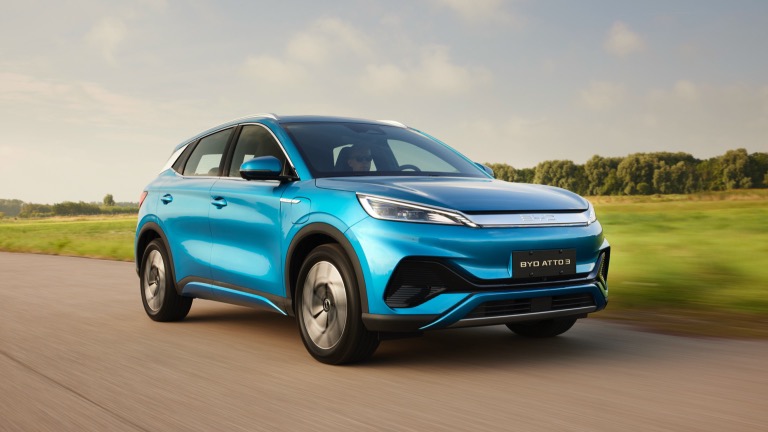
The electric vehicle (EV) landscape in Australia has transformed from a niche market for early adopters to a burgeoning segment packed with genuine, affordable options. For years, the main barrier for most Aussies has been price. But times are changing fast. A flood of new, high-value models—spearheaded by innovative Chinese brands and aggressive pricing from established players—has driven the price point for a practical, well-equipped EV to below the crucial $60,000 mark.
The days of only having expensive, long-range luxury EVs as a choice are over. Today, you can step into a brand-new electric car with respectable range, modern tech, and all the practicality you need for daily Australian life, without breaking the bank.
Here is a deep dive into the Top 5 EVs for the First-Time Australian Buyer under $60,000, focusing on the winning combination of price, range, and practicality.
1. BYD Dolphin: The New King of Affordability
The BYD Dolphin has sensationally redefined what an entry-level EV should cost in Australia, often clinching the title of the nation’s cheapest electric car. It’s a genuine game-changer, proving that going electric is no longer a premium choice.
- 💰 Price: Starting from around $32,000 drive-away (depending on state/trim).
- 🛣️ Range (WLTP): The most popular Premium variant offers up to 427 km. The entry-level Essential provides a still-useful 340 km.
- ⚙️ Practicality Focus: As a small hatchback, it’s a brilliant city car. It’s built on a dedicated EV platform (e-Platform 3.0) and features BYD’s innovative Blade Battery. The interior is surprisingly spacious for its class and is packed with tech, including the much-discussed 12.8-inch rotating touchscreen. Its V2L (Vehicle-to-Load) capability, allowing you to power external devices, adds a layer of unexpected versatility.
Why it’s a Top Pick: The Dolphin’s sheer affordability makes it the most accessible entry point to EV ownership. Its ample range and generous standard equipment mean you don’t feel like you’re compromising, making it a powerful contender for a second family car or a daily commuter.
2. MG4 Electric: The Fun and Frugal Hatch
MG has built a strong reputation in Australia for value-for-money, and the MG4 Electric continues this trend with a sporty, dynamic twist. It’s a sharp-looking hatchback that offers a compelling blend of performance and everyday usability.
- 💰 Price: Starts from around $37,990 drive-away for the Excite 51kWh.
- 🛣️ Range (WLTP): Ranges from 350 km (Excite 51kWh) up to 435 km (Excite 64kWh), placing the mid-range model firmly within the budget.
- ⚙️ Practicality Focus: Unlike many rivals, the MG4 is built on a purpose-built EV platform (MSP), giving it excellent road holding and a fun-to-drive feel. Its rear-wheel-drive layout provides a surprisingly engaging experience. It’s slightly larger than the Dolphin, offering a decent boot space and comfortable seating for four adults. Its long warranty (7 years/unlimited km) and affordable servicing are a huge draw for new EV owners.
Why it’s a Top Pick: If you’re looking for an affordable EV that prioritises the driving experience, the MG4 is the answer. It’s practical enough for a small family while injecting a bit of excitement into the daily commute.
3. GWM Ora: Style Meets Substance
The GWM Ora (formerly known as the Ora Funky Cat) is for the buyer who wants to make a style statement without the European price tag. Its distinctive, retro-inspired design is a major talking point, but underneath the quirky exterior is a surprisingly capable electric car.
- 💰 Price: Starting from around $33,990 drive-away.
- 🛣️ Range (WLTP): The entry-level Standard Range offers 310 km, while the Extended Range lifts this to 420 km.
- ⚙️ Practicality Focus: The Ora’s interior is as unique as its exterior, feeling premium and colourful. While its boot space is on the smaller side for the segment, the cabin is spacious and comfortable, making it a fantastic urban runabout. It comes loaded with safety technology and a high level of standard features, making it feel like a much more expensive car.
Why it’s a Top Pick: The GWM Ora stands out from the crowd. For the first-time EV buyer who values design and a generous features list, its aggressive drive-away pricing and excellent warranty make it an undeniable bargain.
4. Tesla Model 3 (Rear-Wheel Drive): The Benchmark
While the Model 3 might stretch the budget slightly more than the Chinese trio, its latest iteration has seen pricing adjust to place the entry-level Rear-Wheel Drive (RWD) variant well within the $60k ceiling. It remains the gold standard for many, offering a level of technology and charging infrastructure access that is hard to beat.
- 💰 Price: Starts from approximately $54,900 plus On-Road Costs (usually landing just under or at the $60k drive-away mark, depending on state).
- 🛣️ Range (WLTP): A generous official range of around 513 km.
- ⚙️ Practicality Focus: The Model 3 is a mid-sized sedan, offering a blend of exhilarating performance and excellent storage via its rear boot and ‘frunk’ (front trunk). Crucially, it provides access to the world-class Tesla Supercharger Network, which is often cited as the most reliable and fastest public charging option in Australia—a massive selling point for anyone considering longer road trips. The minimalist cabin, dominated by the single central screen, offers a futuristic, tech-forward experience.
Why it’s a Top Pick: For the first-time buyer who wants the absolute best combination of range, performance, and charging convenience, the Model 3 RWD offers an unparalleled package at this price point.
5. BYD Atto 3: The Family-Friendly SUV
For many Australian families, an SUV is the default choice. The BYD Atto 3 was one of the first truly affordable EV SUVs to land and quickly became a market leader. It delivers space, height, and practicality in a well-rounded package.
- 💰 Price: Starts from around $48,011 plus On-Road Costs for the Standard Range (Long Range is also well under $60k).
- 🛣️ Range (WLTP): 345 km for the Standard Range and a more practical 420 km for the Extended Range.
- ⚙️ Practicality Focus: As a small SUV, the Atto 3 offers a higher driving position and easier ingress/egress than a hatchback or sedan. It boasts a roomy cabin and a decent 440L boot, making it highly functional for family duties. Like the Dolphin, it features the Blade Battery, a rotating screen, and V2L capability. It hits the perfect sweet spot for an affordable EV that can comfortably handle the school run, shopping trips, and weekend adventures.
Why it’s a Top Pick: If your first EV needs to be an SUV that ticks all the boxes for space, height, and reliability without pushing past the affordability ceiling, the Atto 3 is the clear front-runner.
Key Takeaway: EV Pricing is Coming Down
The single most important takeaway for any first-time buyer in 2025 is this: The price of a great EV has plummeted.
Just a few years ago, securing a reliable electric car with over 300km of range required a $60k+ budget. Now, thanks to fierce competition and advances in battery technology (like the LFP batteries used by BYD and Tesla), that same budget secures you a market-leading model, with excellent new entrants landing well below $40,000.
The Australian EV market is no longer defined by scarcity or prohibitive cost. It is now defined by choice and value. If you’ve been waiting for the right moment to switch to electric, the combination of lower prices, excellent range, and increasing charging infrastructure means that moment is now. The affordable, practical EV has arrived.
Quick Comparison: Top 5 Affordable EVs for Australian Buyers
Quick Comparison: Top 5 Affordable EVs for Australian Buyers
| EV Model | Indicative Starting Price (Drive-Away Est.) | Key WLTP Range | Practicality & Key Feature Focus | Best For… |
| 1. BYD Dolphin | Around $32,000 | Up to 427 km (Premium) | Cheapest EV, V2L (Vehicle-to-Load), Rotating Screen, good city size. | Budget Buyers and city commuting where affordability is key. |
| 2. MG4 Electric | Around $37,990 | Up to 435 km (Excite 64kWh) | Dedicated EV platform, RWD fun-to-drive dynamics, great safety tech, 7-year warranty. | Buyers who want a sporty feel and excellent all-round value. |
| 3. GWM Ora | Around $33,990 | Up to 420 km (Extended Range) | Unique retro-chic styling, premium-feeling interior, high level of standard features. | Drivers who prioritise style and features over maximum boot space. |
| 4. Tesla Model 3 (RWD) | Approx. $54,900 + ORCs | 513 km | Access to Tesla Supercharger Network, class-leading tech, high performance, large frunk and boot. | Buyers seeking the best range and charging network at this price point. |
| 5. BYD Atto 3 (Extended Range) | Approx. $48,011 + ORCs | 420 km | Small SUV format, high driving position, V2L, ample 440L boot capacity. | Small Families needing the height and space of an affordable EV SUV. |
Note on Pricing: Prices are indicative and approximate for the entry-level or most popular variants as of late 2025. “ORCs” (On-Road Costs) vary significantly by state (Stamp Duty, Rego, etc.). Always check the specific drive-away price for your location.
State government EV incentives in Australia
The most impactful incentive for most employed buyers using a novated lease is the FBT exemption.
That’s an essential piece of information! EV incentives vary significantly by state and territory, and many are being phased out. The biggest single financial benefit, however, comes from a Federal Government tax exemption if you are an employee.
Here is a breakdown of the key incentives available in Australia, current as of late 2025:
🇦🇺 Federal Government Incentives (Australia-Wide)
The most impactful incentive for most employed buyers using a novated lease is the FBT exemption.
1. ⚡ Fringe Benefits Tax (FBT) Exemption (The EV Discount)
- Benefit: Eligible Battery Electric Vehicles (BEVs) and Hydrogen Fuel Cell Vehicles (FCEVs) are exempt from FBT when provided through a salary packaging arrangement, like a novated lease, by an employer. This allows you to pay for the car and its running costs (registration, insurance, charging, etc.) entirely from your pre-tax income, leading to substantial tax savings.
Eligibility:
- The vehicle must be a BEV or FCEV (PHEV exemption mostly ended on April 1, 2025).
It must have been first held and used on or after July 1, 2022.
Its value must be below the Luxury Car Tax (LCT) threshold for fuel-efficient vehicles (currently $91,387 for the 2024/25 financial year).
Impact: This can save employees thousands of dollars per year, often making the total cost of ownership comparable to a cheaper petrol car.
2. Luxury Car Tax (LCT) & Import Tariff Exemption
- LCT Threshold: The LCT threshold for fuel-efficient vehicles (including EVs) is set significantly higher ($91,387) than for regular vehicles, meaning more expensive EVs avoid the LCT.
Import Tariff: A 5% import tariff has been removed for eligible new EVs, which manufacturers typically pass on to the consumer.
State & Territory Government Incentives (Varies by Location)
Many direct cash rebates have ended in the major states, but stamp duty exemptions and registration discounts remain in some regions.
| State/Territory | Primary Incentive(s) Available | Key Eligibility & Status |
| ACT | Interest-Free Loans (up to $15,000). Discounted Registration (emissions-based system). | Loans are for both vehicle purchase and home charging equipment (Sustainable Household Scheme). |
| Western Australia (WA) | $3,500 Rebate | Limited to the first 10,000 eligible vehicles licensed in WA, or until May 10, 2025. Vehicle must be valued below $70,000. |
| Northern Territory (NT) | Free Registration (for new and existing EVs). Stamp Duty Concession (up to $1,500). | Available until June 30, 2027. |
| South Australia (SA) | 3-Year Registration Exemption | For new BEVs/FCEVs valued below $68,750. Available until June 30, 2025. |
| New South Wales (NSW) | Most rebates and stamp duty exemptions have ended. | The $3,000 Rebate and Stamp Duty Exemption ended on January 1, 2024. |
| Victoria (VIC) | Most rebates have ended. | The $3,000 Subsidy ended on June 30, 2023. Minor Rego Discount may apply. |
| Queensland (QLD) | Most rebates have ended. | The ZEV Rebate Scheme ended on September 2, 2024. Minor discount on registration remains. |
| Tasmania (TAS) | Interest-Free Loans (for home chargers). | The $2,000 Rebate has largely concluded/has limited funds remaining. |
Key Takeaway
For new buyers, the single most powerful incentive is the Federal FBT Exemption via a novated lease. For direct purchase, you should primarily look at WA for the $3,500 rebate (if funds remain) and the NT, ACT, or SA for ongoing registration/stamp duty savings.
Case Study: Tesla Model 3 RWD via Novated Lease (FBT Exempt)
A novated lease allows an employee to pay for the car’s finance and all running costs (rego, insurance, servicing, electricity) using their pre-tax salary. The FBT Exemption means the employee does not have to make post-tax contributions to offset FBT, maximising tax savings.
Assumptions for Comparison
| Category | Assumption Value | Notes |
| Vehicle | Tesla Model 3 RWD | Indicative Price: $54,900 (excl. ORC) |
| Purchaser | Employee in NSW | |
| Annual Income | $100,000 | Higher income brackets see greater savings. |
| Lease Term | 5 Years | |
| Annual Kilometres | 15,000 km |
Savings Breakdown: EV Novated Lease vs. Standard Car Loan
| Financial Metric | Standard Car Loan (After-Tax) | EV Novated Lease (FBT Exempt) | Difference (Savings) |
| 1. Upfront GST Saving on Car Price | $0 | Savings of 10% on the vehicle purchase price. | Approx. $5,000 |
| 2. Paying for Running Costs | Paid with after-tax dollars. | Paid 100% with pre-tax dollars (FBT exempt). | Significant (See below) |
| 3. Elimination of FBT Liability | N/A (Directly owned) | FBT is 0%, eliminating the need for post-tax payments. | The key difference: 100% pre-tax funding. |
| Annual Income Tax Saving | N/A | Reduction in taxable income. | Approx. $4,500 – $7,000 per year (Varies by salary) |
| Total Estimated 5-Year Tax Savings | N/A | Combined Income Tax + GST Savings. | $25,000 – $35,000+ |
The Power of the FBT Exemption: The $50,000 ICE Car Equivalent
The true financial benefit is in the reduction of your taxable income.
Standard Novated Lease (for a petrol car): To avoid FBT, a portion of the payment must come from your after-tax salary (Employee Contribution Method). This limits the tax benefit.
EV FBT-Exempt Novated Lease: 100% of the cost (finance, rego, insurance, maintenance, and charging) comes from your pre-tax salary. This drastically lowers your taxable income.
In practical terms, a common outcome for a buyer on an average income is that they can afford a $55,000 EV for a similar or lower weekly outlay than a comparable $35,000 – $40,000 petrol car financed conventionally. The savings offset the EV’s higher sticker price.
Why this is important for your chosen EVs:
All the top 5 EVs you listed (BYD Dolphin, MG4, GWM Ora, Tesla Model 3, BYD Atto 3) are well under the $91,387 LCT threshold, making them perfectly eligible for this maximum FBT benefit.
About EV Evolution
EV Evolution is the leading online platform dedicated to Australian electric vehicle owners and enthusiasts. We foster a vibrant community, delivering essential EV news and insights, and enhancing user engagement through our innovative, AI-powered chatbot for dynamic discussions. Our mission is to empower Australian electric vehicle owners and enthusiasts by fostering a vibrant, AI-driven online community that connects, informs, and advances the nation’s electric vehicle landscape.




